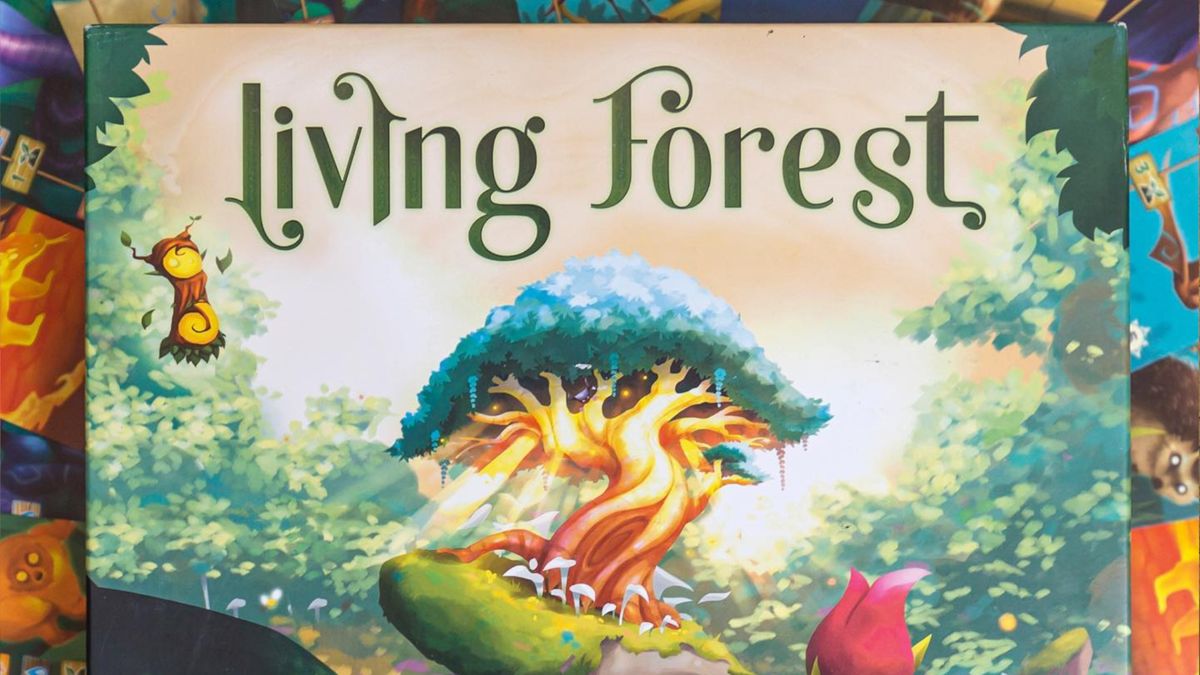12DOVE Verdict
As the winner of one of board gaming's most prestigious awards, Living Forest should definitely be on your radar. Although it may be too complex for some and too simple for others, it's still an excellent addition to your collection.
Pros
- +
Clever amalgam of different mechanics and play styles
- +
Push your luck and interaction offers plenty of excitement alongside strategy
- +
Neat custom components and animal art
Cons
- -
Needs the full four players to shine
- -
A little light for hobby players, a little heavy for families
Why you can trust 12DOVE
As a game from a first-time designer, made available through a small publisher, Living Forest didn’t get much attention until it was catapulted into the limelight through a shock win of one of gaming’s biggest prizes. The Kennerspiel des Jahres is an award from the German board gaming industry aimed at hobby-grade titles, alongside the longer-running and even more prestigious Spiel des Jahres for more family-weight games. As such, earning the gong is a big deal.
So, let’s see what Living Forest offers to rank it alongside its better-known competitors (some of which are candidates for the best board games). Is it worth the fuss?
What is it, and how does it work?
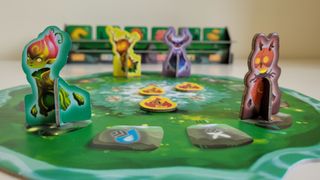
- Game type: Strategy
- Players: 2 - 4
- Complexity: Moderate
- Lasts: 40 mins
- Ages: 10+
- Price: $39.99 / £34.99
- Play if you enjoy: Photosynthesis, King of Tokyo
Living Forest puts you in the shoes of spirits attempting to protect the sacred wood from fires threatening to overwhelm them. Mechanically, it combines a push-your-luck games like King of Tokyo with deck-building and token placement.
The first thing you’ll do in Living Forest is also the most exciting, which is drawing cards from your Guardian Animal deck in the hope of building the actions you want to take during your turn. Each such card has icons associated with one or more in-game actions, and a corresponding value, which can be negative. Once you’ve finished drawing, you’ll tot up all the values shown and see which actions you can take and how powerful they’ll be.
Why, then, would you not just draw your whole deck? Because some of the cards have “solitary” icons, and if you draw three of those, you’ll bust. That means you have to stop drawing, and you can only take one action instead of two, which is very bad news. The draw at the start of each round is thus a push-your-luck affair, where you cross your fingers and hope you get the action totals you want without having to risk a third solitary pull.
Good fun in a fast, accessible package
Taking your actions is where the meat of the game lies. Your goal is to reach 12 in one of the three victory conditions (different trees planted, fires extinguished, or sacred flowers obtained), and each corresponds to a type of action. For starters, you can buy one tree each turn, up to the value of the tree icon total on your cards. Trees provide permanent bonuses, and the more expensive the tree, the bigger the bonus. Next, you can extinguish multiple fires with the water action if you have a high enough water total, but only if there are fires left to put out. Flowers, meanwhile, are obtained during your card draw. Finally, you can get new, more powerful guardian animal cards to your deck as an action.
There’s one other action though, which is to move your piece on the circular forest board where all the player standees are. Doing so nets you a bonus depending on where you land, either a free action of one of the other types, or a useful fragment, which you can spend during your draw to discard a solitary card. In a clever twist, if you can leap-frog another player piece, you get to steal a victory tile from them, which reduces their progress toward one of the win conditions while increasing yours. However, you also set yourself up to be leap-frogged in turn if that player has enough movement action total and chooses to take it.
After everyone has spent their actions, the total of any remaining fires in the forest are compared against each player’s water total. If there’s more fire, that player has to take horrible fire cards into their deck, which add nothing to any action total while still counting as solitary. Fires are added to the forest depending on the cards purchased that turn.
Is it any good?
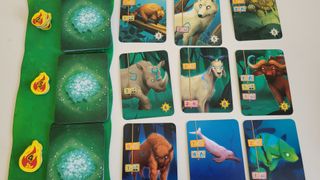
Living Forest is a bold blend of many different game styles, in terms of both mechanics and how it feels to play. For the former, you’ve got deck-building, push-your-luck, and tile placement like I mentioned earlier. As for the latter, it tries to strike a balance between number crunching, spatial strategy, and player interaction. Games like this often take on too much and either fail to satisfy in any one aspect or become clumsy and bloated with rules, but Living Forest nimbly dodges both these perils. It delivers good fun in a fast, accessible package as a result.
When you start out, it’s very tempting to look at the victory conditions and feel you’re best off racing toward one out of the gate. But the game is surprisingly dynamic thanks to the way all the mechanical aspects are interlinked. For example, you can potentially win very quickly via the fire condition because you can extinguish multiple fires per turn. But try that and players before you in the turn order will snaffle up the fires or stop buying cards, so no new ones start. Building up your tree collection, by contrast, is slow and steady, but you need to take more risky draws, and dedicating an action to tree-buying each turn leaves you less able to react to the game state as it changes.
Represents a smart and successful synthesis of styles
And at the heart of proceedings is that board. Movement actions are a bit harder to come by than the others, so you can go a long way - both literally and metaphorically - if you take the opportunity to steal victory tokens off other players. Indeed, the way these tokens change hands toward the end of the game can determine the winner as well as provide plenty of excitement. But to take it, you’ll need to buy cards, which shrinks your tiny action pool as well as gives other players lots of fires to put out as part of that victory condition.
However, that dynamism is very dependent on player count. Although the game lists two to four players on the box, with two it’s hard to catch each other up on the movement board and there’s rarely any threat from fire.
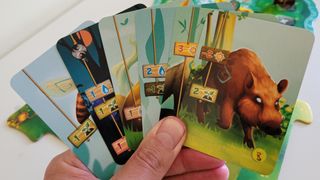
The victory conditions don’t feel entirely balanced, either. The game feels much more intense and interactive as you add players and is best with four, but there’s a trade-off. It also becomes that much more random as a player may get the chance to grab multiple fire tokens or even leapfrog multiple players in a move if they’re lucky.
At no player count is this a particularly heavy strategy game, but it’s potentially fun if you want board games for families and friends. You may find it’s a tiny bit complicated to explain, though, with all the little moving parts, none of which will feel familiar to people who’ve only encountered mass market games. They will, however, probably enjoy the production values with the curious little tree dispensers and the blank-eyed spirit animals striking just the right balance between cute and scarily mystical.
Overall - should you buy Living Forest?
Despite its undoubted qualities, Living Forest feels a bit like a game in search of an audience. For a game with a Kennerspiel nomination, it’s a bit lightweight for the hobby crowd seeking board games for adults. But at the same time, it has a few too many bells and whistles for mainstream success. And that’s kind of a shame, because Living Forest represents a smart and successful synthesis of styles and concepts. That’s a rare achievement, and it’s worth celebrating by checking out this game.
Matt is a freelance writer specialising in board games and tabletop. With over a decade of reviews under his belt, he has racked up credits including IGN, Dicebreaker, T3, and The Guardian.

Despite Zelda: Majora's Mask basically being a horror game, one of its key devs didn't think its creepiest features were scary at all: "People on the team were like 'whoa!'"

Corsair exec says GTA 6 is coming to PC in early 2026 and then quickly un-says that
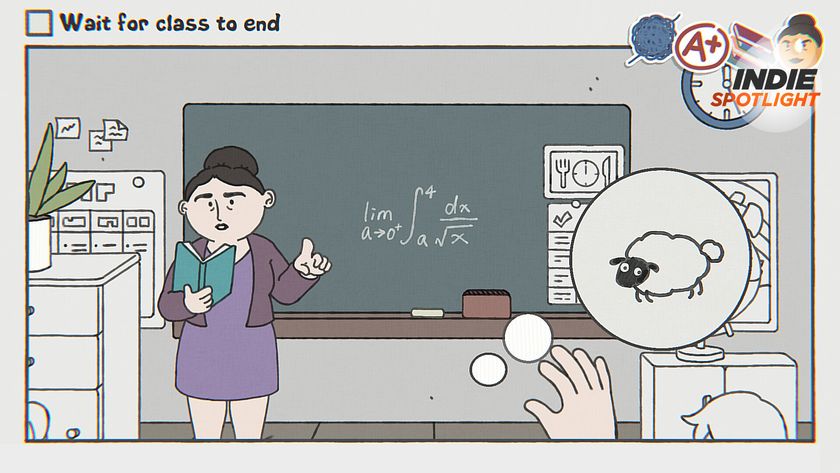
This puzzle game has done the impossible: waiting around for something to happen has never, ever been this fun
Most Popular





